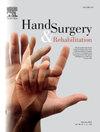双活动的梯形腕关节假体:当前文献综述。
IF 1
4区 医学
Q4 ORTHOPEDICS
引用次数: 0
摘要
第一腕掌关节骨关节炎是一种常见疾病,影响到70%的普通人群,有症状的疾病发生在6%的病例中,主要发生在绝经后妇女中。在治疗选择中,全假体置换术是越来越突出的斜跖关节。这篇综述的目的是提供一个全面的更新双活动全关节置换术的梯形腕关节。PubMed, b谷歌Scholar和MEDLINE检索了有关双活动斜骨腕骨假体结果的相关出版物。采用非随机研究方法学指数(未成年人)评估偏倚风险。效应模型(EM)采用Cohen's d指数计算。10项研究共纳入931例患者。植入两个假体模型(Moovis和Touch)。在931个植入物中,25个(2.7%)失败并需要手术翻修。QuickDASH的合并随机EM为34.15 (95% CI, 23.53;44.77, I2 = 99%), -2.36 (95% CI, -4.24;-0.47, I2 = 99%), -7.49 (95% CI, -8.94;握力为-6.04,I2 = 82%),握力为-2.43 (95% CI, -2.92;-1.94, I2 = 91%)为键夹强度。在活动范围和握力的早期恢复方面,双活动提供了良好的功能结果,与标准手术相比,脱位率较低,对于中度功能需求的晚期斜跖骨关节炎患者应予以考虑。本文章由计算机程序翻译,如有差异,请以英文原文为准。
Dual mobility trapeziometacarpal prosthesis: A review of the current literature
Osteoarthritis of the first carpometacarpal joint is a common condition affecting up to 70% of the general population, with symptomatic disease occurring in 6% of cases, predominantly in postmenopausal women. Among the therapeutic options, total prosthetic replacement of the trapeziometacarpal joint is gaining prominence. The aim of this review is to provide a comprehensive update on dual mobility total arthroplasty of the trapeziometacarpal joint.
PubMed, Google Scholar, and MEDLINE were searched for relevant publications that addressed the outcomes of dual mobility trapeziometacarpal prostheses. The Methodological Index for Non-Randomized Studies (MINORS) was used to assess the risk of bias. The effect model (EM) was calculated using the Cohen's d index. Ten studies with a total of 931 patients were included. Two prosthetic models were implanted (Moovis and Touch). Of the 931 implants, 25 failed (2.7%) and required surgical revision. The pooled random EM was 34.15 (95% CI, 23.53;44.77, I2 = 99%) for QuickDASH, −2.36 (95% CI, −4.24; −0.47, I2 = 99%) for Kapandji score, −7.49 (95% CI, −8.94; −6.04, I2 = 82%) for grip strenght, and −2.43 (95% CI, −2.92; −1.94, I2 = 91%) for key-pinch strenght.
Dual mobility provides a good functional outcome in terms of range of motion and early recovery of pinch and grip strength, with a lower rate of dislocation compared to standard surgical procedures, and should be considered in patients with advanced trapeziometacarpal osteoarthritis with moderate functional demands.
求助全文
通过发布文献求助,成功后即可免费获取论文全文。
去求助
来源期刊

Hand Surgery & Rehabilitation
Medicine-Surgery
CiteScore
1.70
自引率
27.30%
发文量
0
审稿时长
49 days
期刊介绍:
As the official publication of the French, Belgian and Swiss Societies for Surgery of the Hand, as well as of the French Society of Rehabilitation of the Hand & Upper Limb, ''Hand Surgery and Rehabilitation'' - formerly named "Chirurgie de la Main" - publishes original articles, literature reviews, technical notes, and clinical cases. It is indexed in the main international databases (including Medline). Initially a platform for French-speaking hand surgeons, the journal will now publish its articles in English to disseminate its author''s scientific findings more widely. The journal also includes a biannual supplement in French, the monograph of the French Society for Surgery of the Hand, where comprehensive reviews in the fields of hand, peripheral nerve and upper limb surgery are presented.
Organe officiel de la Société française de chirurgie de la main, de la Société française de Rééducation de la main (SFRM-GEMMSOR), de la Société suisse de chirurgie de la main et du Belgian Hand Group, indexée dans les grandes bases de données internationales (Medline, Embase, Pascal, Scopus), Hand Surgery and Rehabilitation - anciennement titrée Chirurgie de la main - publie des articles originaux, des revues de la littérature, des notes techniques, des cas clinique. Initialement plateforme d''expression francophone de la spécialité, la revue s''oriente désormais vers l''anglais pour devenir une référence scientifique et de formation de la spécialité en France et en Europe. Avec 6 publications en anglais par an, la revue comprend également un supplément biannuel, la monographie du GEM, où sont présentées en français, des mises au point complètes dans les domaines de la chirurgie de la main, des nerfs périphériques et du membre supérieur.
 求助内容:
求助内容: 应助结果提醒方式:
应助结果提醒方式:


